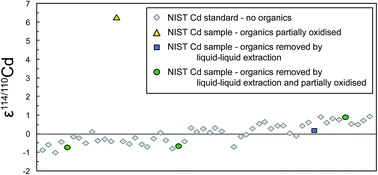Improvements in Cd stable isotope analysis achieved through use of liquid–liquid extraction to remove organic residues from Cd separates obtained by extraction chromatography†
Abstract
Organic compounds released from resins that are commonly employed for trace element separations are known to have a detrimental impact on the quality of isotopic analyses by MC-ICP-MS. A recent study highlighted that such effects can be particularly problematic for Cd stable isotope measurements (M. Gault-Ringold and C. H. Stirling, J. Anal. At. Spectrom., 2012, 27, 449–459). In this case, the final stage of sample purification commonly applies extraction chromatography with Eichrom TRU resin, which employs particles coated with octylphenyl-N,N-di-isobutyl carbamoylphosphine oxide (CMPO) dissolved in tri-n-butyl phosphate (TBP). During chromatography, it appears that some of these compounds are eluted alongside Cd and cannot be removed by evaporation due to their high boiling points. When aliquots of the zero-ε reference material were processed through the purification procedure, refluxed in concentrated HNO3 and analyzed at minimum dilution (in 1 ml 0.1 M HNO3), they yielded Cd isotopic compositions (ε114/110Cd = 4.6 ± 3.4, 2SD, n = 4) that differed significantly from the expected value, despite the use of a double spike technique to correct for instrumental mass fractionation. This result was accompanied by a 35% reduction in instrumental sensitivity for Cd. With increasing dilution of the organic resin residue, both of these effects are reduced and they are insignificant when the eluted Cd is dissolved in ≥3 ml 0.1 M HNO3. Our results, furthermore, indicate that the isotopic artefacts are most likely related to anomalous mass bias behavior. Previous studies have shown that perchloric acid can be effective at avoiding such effects (Gault-Ringold and Stirling, 2012; K. C. Crocket, M. Lambelet, T. van de Flierdt, M. Rehkämper and L. F. Robinson, Chem. Geol., 2014, 374–375, 128–140), presumably by oxidizing the resin-derived organics, but there are numerous disadvantages to its use. Here we show that liquid–liquid extraction with n-heptane removes the organic compounds, dramatically improving quality of the Cd isotope data for samples that are analyzed at or close to minimum dilution factors. This technique is quick, simple and may be of use prior to analysis of other isotope systems where similar resins are employed.

- This article is part of the themed collection: JAAS 30th anniversary

 Please wait while we load your content...
Please wait while we load your content...